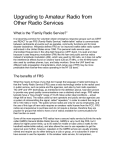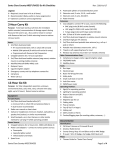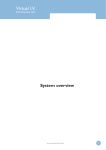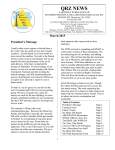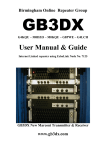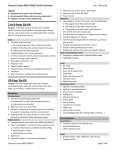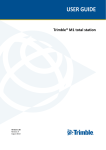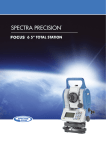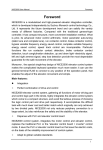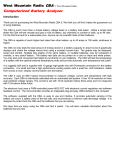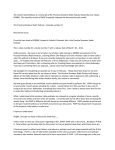Download Ham Radio Training for Responders and Groups
Transcript
Radio Communications Training for First Response Volunteer Citizens Groups This handout is designed to assist volunteer disaster service workers who will be using two-way radio communications. It is based on the fact that most people who belong to volunteer community response teams do not have the level of training necessary for efficient communications, and is designed to cover information that can raise the skill level of these radio operators in order for the response or event to function smoothly and professionally. In addition to the information provided in this document, there is no substitute for experience, so I want to encourage all of the teams and organizations that will be utilizing this training document to schedule a series of regular training drills and exercises, and to participate whenever possible in community functions such as providing communications support at parades, marathons and community events. After each drill or event, get together as a group and discuss what went right and what needs to be improved. Continue to learn from your mistakes until you find that you are no longer making any mistakes! You may see occasional reputations of information at different places in this document. The reason for this is to attempt to provide the information for different radio services in ways that make the most sense and provide a logical continuity. Using FRS radios Because of the low cost, ease of use, and no license requirement, FRS radios are great radios for CERT teams REACT teams and American Red Cross disaster service workers for radio communication within the team and for radio communication with CERT/REACT/ARC local command. Follow the simple“FRS radio basics outlined in this document. To make it easier for everyone on the team to use these radios, do not use squelch codes (tones). Most“blister pack radios sold today are dual purpose (FRS/GMRS) and CERT trailers and teams will most likely have this type, so assign & practice with FRS only channels (8-14) and do not use the GMRS frequencies unless all (or key) team members have a GMRS license. Referring to channels and frequencies FRS radios have 14 channels that can be selected by the user. Each channel is identified simply by its assigned channel number, and it is useful to know that each channel is also assigned an individual frequency. For example, channel one on the FRS radio can be referred to as “FRS 1” and it can also be called “5625” because it operates on the frequency of 462.5625 megahertz (MHz). The amateur radio service is not channelized, so hams refer only to the operating frequency, either stating the full frequency, such as 146.520, or the numbers following the decimal point as above, which in this case would be “520.” If the frequency is assigned to a repeater, the user may refer to the frequency by using the name of the repeater. For example, in my home area, the local repeater association, SANDRA (San Diego Repeater Association), has a repeater available for our use at the top of Mt.Otay operating on the 2 meter output frequency of 146.640. Instead of saying that we are using the 146.640 frequency, we say instead that we will use the SANDRA “Otay repeater” or “the Otay machine.” Remember that FM repeaters have an input frequency that is different from the output frequency, and generally require a PL tone to open the tone squelch. This information is beyond the technical knowledge level of this document, but is explained in the article “Guide to Using Repeaters for New hams by AA6TS.” available from the AA6TS web site “Tom’s Radio Shack” at http://tomsmerk.com/radio/repeaters.pdf. There are certain frequencies set aside for special purposes, such as FRS channel 11, the “National Drill Channel,” or the National Simplex Calling Frequencies of 146.52 on the amateur radio 2 meter band, 222.1 on the 1.25 meter band, and 446.00 on the 70 centimeter band. This allows users to “wait” on this frequency to see if anyone is trying to contact you, and then once a contact is established, you would move your conversation to a different frequency to reserve the calling channel for initial contacts only. You would need to check in advance for a frequency that is not being used, and then relate the selected frequency to the other users by stating the frequency, such as “switch to 146.52 simplex,” or “go up 10” (from .52 to .62). You can also have users switch to a repeater frequency, such as “switch to the Otay machine “or “switch to 640” (see above). Selecting frequencies for team drills and changing frequencies as necessary It will be the responsibility of the communications coordinator and net control operator to choose the mode and band best suited to the need. There is, of course, no alternative to using what happens to be available, but there are ways to optimize available communications. Plan several drills each year to test all available modes and bands in order to have an idea of “what works when and where” so that you will have a better chance of choosing the best communications plan in the event of an actual emergency. Know where your “dead spots” are on each of the bands, and become familiar with the range potential of each of the different types of radios that may be used. Communication protocol for drills and events should be established ahead of time and included in the team manual or handbook, or the information for each event might be different and is presented to the team members who will be using radios at the meeting point or staging area in a briefing before assignments are made. If your team had you program your ham radio in advance with all of the frequencies that the team might use, then this is a simple matter of selecting which frequencies will be used for the various functions at today’s drill or event. If no advanced programming was made, then the communications coordinator will tell you what frequency you will be using and you will need to enter it into your radio if it is not already stored. If you are using FRS radios instead of ham radios, you will be using one of the 14 available channels and will not have to program any frequencies. Even though each of the channels on FRS/GMRS radios is assigned to a specific frequency, it is not necessary for you to know the frequency in order to effectively use the radio. You will simply refer to the channel number. If the event covers a small area, it is common practice to use simplex frequencies which work well within small areas. Communications over a wider area or communications with other agencies may necessitate the use of repeaters, so you will need to enter information into your stored frequencies in memory to access the repeater as described above. Typically, either the entire team will use the same frequency, or different functions or positions will each use separate frequencies and all of the different frequencies being used will be monitored by net control, who will be responsible for relaying information between “groups.” Turning on your FRS radio Note: Before we go any further, be sure that you have read and that you understand your entire user’s manual for your FRS radio. Every make and model is a little different, so it is impossible for me to provide specific operating instructions here. If there is anything in the manual about the features and use of your radio that you do not understand, ask your team communications coordinator before the event. When you show up at an event, you are expected to be fully trained and ready to function! Another thing to do in advance it to make sure that you have either charged your radio batteries or installed a fresh set of batteries. Take extra alkaline or NiCad batteries or an extra battery pack with you to the event as a backup. When you arrive at a callout, you will be briefed by your communications coordinator or event coordinator as to what frequencies will be used and any other instructions that are necessary to know for this event. The coordinators might divide the responders up into different teams and assign different channels to each team, or they might coordinate the entire event on the same channel. Once you know which channel to use, turn on your radio and use the knob or up/down buttons on your radio to select the operating channel. Next, adjust your squelch so that it will block out noise or static on the channel but still allow all radio transmissions to be heard. This is usually accomplished by starting with your squelch completely off. Turn up the volume until you hear a static noise. Then adjust the squelch higher, using small increments, until the noise is blanked out, and then stop adjusting. If you turn your squelch up too high, it will also squelch out people trying to communicate with you – you will not hear them! You should wear your radio in such a way that you can hear it. Different people have different preferences. Here are a few ways you can easily function with your radio: One method is to clip the radio to your belt and turn it up loud enough to hear over background noise. Another method is to use an earphone or headset to make it easier for you to hear the communications over the background noise. A third method is to use a speaker/mic (an accessory that combines the speaker and microphone as one element that plugs into your radio). You can clip the radio to your belt and clip the speaker/mic to your lapel where it is closer to your ear and mouth. Some people unclip the microphone to talk, others just leave it clipped to the lapel and push the press to talk (PTT) button. Another method that is becoming popular for radio specialists is to wear a radio vest or chest harness. This is a sling worn over the head that covers your chest with several pockets to hold various radios such as an FRS radio, a ham radio, a CB radio and a scanner. Most people feel more comfortable with this arrangement rather than having four radios clipped to your belt. After all, you can’t run from danger if your pants fall down from the weight of all the radios on your belt! Radio Check Before you go into the field to begin your assignment, it is necessary to make sure that your radio is functioning properly. This is accomplished through a radio check. Your coordinator will usually give you instructions on when and how to do a radio check. If you have not received any instructions, after you have turned on your radio, selected the proper channel, and adjusted the volume and squelch, hold the radio about an inch or two from your mouth and key the mic (press the push-to-talk button), saying something appropriate such as “Unit 7 to base, requesting a radio check,” or “net control, this is unit 7. Can I get a radio check?” It is usually a good idea to request another radio check when you get to your “post” if your location will be far away from your staging area, mainly to make sure that there is nothing blocking your signal and that you have not exceeded the range of your radio. Operating Procedure Once you have tested your radio and have reached your assigned position, please observe the following procedures. Although communications procedures can vary from one organization to another, I have attempted to provide a universal set of suggestions that follow established etiquette and protocol. 1. Unless instructed to check in at regular intervals, do not make any communications unless it is necessary. If net control does not hear from you, they will assume that everything is OK at your position. There is usually a lot of radio traffic already, and you don’t want to add to the confusion with unnecessary transmissions. Net control might want to schedule a “roll call” every 30 or 60 minutes to make sure every is still at their assigned station. 2. Don’t ever break into a disaster net just to let them know that you are there if needed. 3. In emergency net communications, the word “break” usually means “this is an emergency,” so be careful not to use that word unless you have a valid emergency to communicate. Instead, use words such as “comment” or “net control, this is _____ .” 4. All communications should go through net control. Do not communicate directly with another unit. 5. Before transmitting, listen first for a few seconds to make sure that the frequency is not in use. 6. When you want to speak into the radio, hold your microphone about an inch or two from your mouth, press the PTT (press to talk key), wait a second, then begin talking in a normal tone of voice. Finish your sentence before you release the PTT key. Many people begin talking at the same time that they press the PTT key, and this causes the beginning of their message to be cut off. Think of PTT to actually mean “Press, then talk” to make sure that you wait a second before you speak. 7. It is also a good idea to pause for a second or two between communications to see if there is any emergency traffic that needs to break in or if there is someone that needs to add information concerning your communication. 8. Make sure that your body is not interfering with the transmission of the antenna. If you are having trouble “getting out,” you can hold the radio high in the air and let the speaker/mic cord reach down to your mouth. This is a good example of when you might want to use the speaker/mic accessory. Under normal conditions, it is more convenient to clip the handi-talkie to your belt or to place it a pocket in your chest harness. 9. Always use clear, plain English communications. Do not use radio codes, Qcodes, slang or jargon unless approved by the team communication procedures. 10. If you feel it would improve accuracy of someone copying your transmission, go ahead and use the phonetic alphabet to spell out unique names and places, such as “November Six Tango Kilo Tango” instead of AA6TS. Use standard International Telecommunications Union phonetics, which can be easily found on the Internet. Also, learn how to properly say numbers over the radio. Read each numeral individually. For example, say two three four rather than two hundred thirty four. Enunciate each numeral. Always say zero and never say “oh.” Pronounce nine as “niner.” 11. Talk slow. The biggest cause of errors during voice communications is one of the operators talking too fast. The receiving operator either misunderstands or misses parts of the message. 12. Do not “kerchunk” the repeater (press the PTT key to see if you are able to get into the repeater). If you must check your repeater accessibility, it is better to key the microphone, give your call sign, and say “testing.” Once you are able to determine that you are able to use the repeater, transmit your call sign again, and say “testing complete.” 13. Respond to the question asked. I often hear people respond to questions with any number of responses that give information but did not actually answer the question that was asked. Whenever someone asks you a direct question, such as “do you need a break,” think to yourself “did I answer the question properly with sufficient information.” If in doubt, ask “Does that answer your question?” 14. Be alert at all times to radio traffic. Do not get sidetracked and miss an important announcement or communication. 15. It is usually going to be noisy where you are stationed. The noise might be from victims, survivors, emergency personnel and equipment, or possibly even a lot of other radios squawking loudly on a variety of frequencies. To make it easier to hear what you need to hear, consider using an earphone or a headset. What I like to do is to put an ear bud in one ear and leave the other ear free so I can easily hear both radio traffic and local communications. There are special noise cancelling headsets and ear buds available that have a removable plug to allow you to also hear what is going on around you. The plug can be replaced when you need to block out all background noise. 16. If advised by your communications coordinator, and if you have additional radios available such as an FRS radio, ham radio HT or a scanner, or even a CB radio, you may want to monitor additional frequencies to be better informed about the “big picture,” but do lose track of your main assigned frequency – pay closest attention to this frequency. 17. Know your duties and do not exceed your duties or limitations. If someone asks something that is not part of what you are assigned to do, please refer them to the proper contact person. People that try to do everyone else’s jobs usually don’t do their own job as well as they could! 18. Keep personal comments and opinions off the air. You never know who is monitoring the frequencies, and your critical comments might end up in the newspaper, bringing embarrassment to the whole operation! 19. Use cell phones for private or personal communications. Never transmit information of a private and personal nature over radio frequencies. Anybody could be listening, and might use this private information improperly. 20. Do not use VOX. “VOX” stands for “voice activated transmissions,” and means that if this setting is turned on, anything you say will key the microphone and make it active. VOX is sometimes useful if you are doing a “rag chew” in your quiet shack at home, but in the field, even background noise can key the microphone accidentally. If VOX is turned on, things you say could be transmitted without your knowledge. Always check your radio to make sure VOX is turned off – do not assume that it is off! 21. Do not spread rumors. During a disaster or emergency response, a lot of information gets transmitted, and sometimes it gets relayed improperly and the information changes and becomes false, leading to new problems. It is best just to keep your mouth shut about what you hear. 22. Do not alter a message, even to correct a typographical error. What you think is right may actually be wrong. Moreover, any change you make might alter the meaning of the message. Send or write it exactly as you receive it. When taking messages or passing traffic, accuracy is your number one priority. 23. Know what radio traffic is permissible depending on the nature of the event. There is a wide difference between public relations and emergency communications. You should not get too involved in providing public relations that you fail in your job to handle emergencies. As people approach you and ask questions and make requests, evaluate each request and use existing protocol to decide which information needs to be radioed to net control and which needs to be referred to other personnel. 24. Be ready for any sort of reassignment, whether it is simply to change channels or frequencies, or to move to a different post or location. One of the hardest parts of an emergency net control operator is to have the need to reassign personnel and not be able to get ahold of them or to have them misunderstand directions. 25. If a directive is given, always confirm it with net control to be sure that you have all of the correct information. 26. Contact net control if you need to be relieved. Do not leave your post unless you have made notification and are granted permission. If you are in a critical position, the coordinator might want to physically have someone replace you before you leave your post. 27. Leave your pets and children at home or arrange to have them cared for. You want to give this assignment your full concentration. 28. Check your appearance. You want to dress comfortably and be able to work in less than ideal conditions, but don’t show up in sloppy dress. Keep your outfit comfortable, but also neat and clean, and wear team uniforms when requested to. 29. Write everything down. After the event, you might be asked to comment on a situation. Do not rely on your memory – have everything in writing. This includes what net control says to you, what other responders say to you, what public officials and emergency personnel say to you, and what the public says to you. Include your thoughts and comments that could help you later to remember the incident. Include times with each written comment. 30. When the event has concluded, follow instructions on how to disperse. You may need to return to the staging area, or you might need to meet for a debriefing, or perhaps you might be given permission to leave for home. In any case, be prepared to contribute any information that you encountered during the event that would be useful for the event coordinators to document everything that occurred that would be useful to put into the “after action report.” 31. If you have any questions, contact net control. Never be in doubt, and even more importantly, never guess! 32. Carry a notepad, and write down anything that happens that you want to ask about later. Never trust your memory. An accurate description of events will always lead to a better answer. 33. Have in your possession any user’s manual or programming instructions for your radio in case you have to refer to an operation that you are not familiar with. You may need to use one of its special features or to enter a new frequency that is not already programmed into memory. 34. Always have all necessary identification with you. This includes your disaster worker identification or ARES/RACES/CERT/ARC ID, your driver’s license and your ham radio license. Using Amateur (Ham) Radio for Communications FRS radios are widely used in community response groups such as CERT, REACT, American Red Cross and others because they are inexpensive, easy to use and do not require a license or examination. When it comes to the ultimate radio to handle emergency communications, ham radio is far above all others. Unlike public service or GMRS radios, it does not require that the user be employed as a city or county emergency service responder, nor does it require a license fee to use the service. The amateur radio service is versatile, providing handheld battery “handi-talkies” for use in the field, mobile radios for extended range from vehicles, and base stations that will either communicate with the handi-talkies” on the FM VHF & UHF bands, or communicate worldwide with other public service agencies and nets to exchange important messages on coordinate response on a national or international basis using the HF (high frequency) bands from 160 meters to 10 meters). Ham radios are also excellent for communications from CERT team “monitors” to the local, city or county EOC (Emergency Operation Center). Most ham radios can monitor all FRS/GMRS frequencies and can be set to scan all frequencies, so ham radios are very useful for monitoring multiple teams, but ham radios cannot be used to communicate to the teams on FRS or GMRS frequencies. Many "radio specialists" on a CERT or REACT team will carry one of each radio, and in some cases, also carry a scanner to listen to public safety communications such as police, fire and EMS that might be of interest to those coordinating response activities. The goal of most emergency response teams is to provide or specify FRS radios for routine communications to anyone who wishes to participate, and then to utilize as many ham operators available on the team to handle the longer-range communications. Usually, a net control operator is assigned at each incident, event or drill. The net control operator is equipped with as many different types of radios as possible to provide communications to a wide range of participants. Sometimes local or county public service agencies will make available radios covering frequencies used by EMS, first responders, and fire or law enforcement so that communications between citizens groups and EMS professionals is possible. I have even seen net control stations use citizens band (CB) radios because it is possible that CB users might be attempting to request help or relay information on a CB radio. My motto is “whatever works, use it!” The above operating procedures for FRS radios are also true for those who will be using a ham radio, with the following exceptions or additions: 1. While FRS and CB radios use “channels,” ham radios instead use “frequencies.” The confusing part is that you will usually store these “frequencies” into any of a number of “channels” (memory banks) in your radio. For example, in my HT (handi-talkie), I have the SANDRA Mt. Otay 2 meter repeater with a frequency of 146.640 stored in memory channel 107. But I should not refer to this as “channel 107” because it is only 107 for me, and a different team member might have the same frequency stored in a different channel, such as 12, or 200. The proper 2. 3. 4. 5. 6. 7. 8. way to refer to this frequency is determined by pre-established procedures that the team has developed. Proper ways of identifying this frequency could be by saying either “146.640” or “640” or “146.64” or “the SANDRA Mt. Otay repeater” or “the Otay machine,” among other accepted methods. Make sure that you are familiar with the method your team will be using to refer to ham radio operating frequencies. When using ham radio, you must always follow FCC regulations. It is your responsibility to study and learn these regulations. During emergency response or disaster communications, these regulations might be different from routine communications, so make sure you have been instructed by your communications coordinator on how to conduct emergency communications. For identification, you might be requested to use your personal call sign, your team or event call sign, or your post designation (tactical call sign), such as “south overpass” or “announcer 1,” “4th & Main” or possibly a combination of these identifiers. If using tactical call signs, be sure to also give your FCC call sign every ten minutes. Be sure that you were trained in advance how you will identify yourself when using ham radio for an emergency event, and that you completely understand each procedure. There are further instructions on this topic in the FCC Part 97 regulations (available from the FCC, the ARRL, from the Internet, or from local radio and electronics stores) and in many disaster communications field guides. Remember that your communications on a ham radio will usually be heard over a wider area that an FRS or CB radio, so act accordingly. Amateur radio use in disasters or emergencies might involve the use of HF base, mobile or field radios for statewide, national or international communications. I have noticed an emerging trend toward the development of ham radio “go kits.” These kits package together into a briefcase or similar portable container an HF mobile transceiver, a 12-14 volt battery, a portable antenna tuner, a digital data interface, and any of several choices for an antenna, ranging from a mobile antenna such as a screwdriver antenna or hamstick, to a portable vertical antenna, to a dipole or long wire that is hoisted up into a tree. Communications trailers and emergency operations centers are usually equipped with HF radio equipment, as are many local facilities such as fire departments. Be sure to always have your FCC amateur radio license in your possession as well as credentials for your emergency communications organization such as RACES or ARES. Keep with you a copy or your radio owner’s manual, pocket guide or programming instructions in case you need to enter in a different frequency and you don’t know how, or in order to perform one of many functions that you need to know about your radio. Always decide in advance what frequencies your team will use for emergency or disaster communications. Assign a “talk-in” frequency, that will be used as volunteers arrive, to direct them to the proper area. Use another frequency for general information and announcements. This same frequency could be used to deploy volunteers. When disaster strikes, your team should automatically turn on their radio and monitor this frequency for deployment instructions. For every repeater frequency, have a simplex frequency also assigned in case the repeaters go down (lose power or are physically destroyed), or you could instruct the team that if this should happen, use simplex mode on the “output” frequency of the repeater. Some radios have this feature, called “reverse,” readily available as a button or switch. Entering or programming frequencies into your ham radio You will need to refer to your owner’s manual for this step because different makes and models of radios use different techniques to accomplish this. What you need to understand is that to enter a frequency into your FM handi-talkie, you will need to enter the input frequency, the output frequency, and the squelch tone, also called the “PL tone” (from the original trademark used by Motorola, “Private Line”). In some areas you can talk on your UHF/VHF handi-talkie without having to worry about setting up repeaters. This method of point-to-point communication is known as “simplex.” As you travel, listen to 146.52, which is the “National Calling Frequency.” The way this works is to establish contact on this frequency and then move to another frequency or to a local repeater once contact is established to keep the calling frequency open. You will probably not hear much on this frequency as most people use repeaters. Repeaters are radio devices that are usually mounted high on a mountain top or else in a location that is convenient to access. They receive a weak signal from a handheld or mobile transmitter, amplify it, and then retransmit the signal. Repeaters allow us to talk over further distances than we could if we were talking direct between two transceivers. Repeaters are usually available for free for everyone to use, even though they are owned by a club or organization and are primarily intended for use by their members. This is yet another good example of the “good nature” of ham radio operators who would rather give you something rather than withhold something from you! There are a few exceptions (not many), and your repeater directory (discussed below) will let you know which ones are free and which are membership only. Most of the communications on the popular UHF and VHF bands (the 2 meter band (144-148 MHz), the 1 ¼ meter band (222-225 MHz), and the 70 centimeter band (420450 MHz) happen on repeaters. You should get a good local repeater directory, either in print version at the store, or lookup the information online, and program your radio for all the frequencies in your home area that you may be likely to use. If you are on a CERT team or REACT team, your team communications coordinator might have a list of frequencies that you will be using. Some teams have software available to easily program your radio with these frequencies, or you can get a copy of the list and program the memory channels yourself. Most of us eventually establish a "home" repeater that you monitor on a regular basis so that is anyone wants to contact you, they will know that you are usually listening to this particular repeater. For example, if you are ever in the San Diego County area, you can find me (AA6TS) on 146.64 (-) with a PL tone of 107.2. The "-" means that the frequency that you program to get "into" the repeater is 600 kHz lower that the frequency you listen to, so you would program the "input" to 146.040 and the "output" to 146.640, and then also tell it to use a tone of 107.2, one of a list of standard tone frequencies that are used. If you were to listen to this on a receiver or monitor, you would dial to 146.640. On the 2 meter ham band the offset frequencies are 600 kHz (600 kilohertz) apart. On other bands, the offsets are different. With a few exceptions, if the output frequency (transmit frequency, the frequency that you listen to) of the repeater is below 147 MHz, then the input frequency (listening frequency, the frequency that you must transmit on to contact the repeater) is 600 kilohertz lower. This is referred to as a negative ( - ) offset. If the output is 147 MHz or above, then the input is 600 kilohertz higher. This is referred to as a positive ( + ) offset. Most ham radios sold today automatically set the offset once you have chosen the operating frequency. For example: If the repeater output is 146.840 MHz, the input, or the frequency it listens on, is 146.240 MHz (600 kilohertz lower). If you have your radio tuned to 146.840 MHz, (the repeater's output frequency), when you push the microphone button, your radio automatically transmits on 146.240 MHz, 600 KC down from 146.840. When you release the microphone button to listen, your radio switches back to 146.840 MHz to listen on the repeater's output frequency. There are exceptions to the rule, so check local repeater listings. You can usually hear the output of the repeater without a tone, but you need the tone to "talk to" the repeater, so any scanner can monitor the frequencies. By requiring a certain tone to access the frequency, you won’t be interrupted by other users on the frequency – only those that are using the same tone. This allows for a certain amount of privacy so that you will only hear transmissions from other people using the same tone. Almost all repeaters use tone squelch, so you will need a radio that allows you to program a tone into a memory along with the frequency of the repeater. Your radio manual will explain how to do this, and the repeater directory will have the information that you need to enter. The tone that we refer to is usually referred to as a “PL” tone, which is an abbreviation of the Motorola Trademark “Private Line.” The generic name for this “tone” is “Continuous Tone-Coded Squelch System” (CTCSS). There are other types of tones that will mute the audio (squelch), but these are less common. If your radio allows for a variety of different tone squelch methods, refer to the repeater guide, as it will tell you if you need to use any less common type of tone, which will rarely be needed. I use computer software that makes programming easier, especially if you travel a lot and will be changing frequencies often. Leave a lot of memory channels open so that you can program them for repeaters in areas you will be traveling through, and then either change them as you move on, or leave them in memory for the next time you are in that area. You can "lock out" the frequency until you need it again. You can search for these frequencies online, such as by using a search phrase similar to "San Diego repeaters" or you can get the ARRL repeater directory (or a national repeater directory from a different company) which covers the whole country. There is also software available for about $40 that makes it easier to find repeaters. If you have trouble finding local repeaters as you travel, there are some web sites such as K1IW Amateur Repeater and Broadcast Transmitters Database Websearch at http://rptr.amateurradio.net/arn/rptr with repeater search engines to help you find repeaters in areas that you will be traveling through. If you will be using your radio only for CERT or REACT drills, then you only need to enter the frequencies recommended by your team communication coordinator, and not have to worry about the rest of these steps. However, if you will also be using your radio for personal use, we hope that this document will provide enough additional information to make this easier for you to accomplish. As you travel, just choose a repeater that looks like a likely candidate, key up and say "(call sign", mobile, monitoring" – for example, I would say "AA6TS, mobile, monitoring." This is like saying CQ, but adapted to the VHF/UHF etiquette. This is an invitation that you would like to talk to someone, so once you announce your call sign, listen for another ham to respond to your call. Of course, if you want to contact a specific user, you can use the traditional method of “KJ6NTB, this is AA6TS,” which means “KJ6NTB, are you there? This is AA6TS, and I’m trying to get in touch with you.” Once the other party responds, carry on a normal conversation, announce your call sign every ten minutes, and give your call sign again when you are finished with your conversation. It is not necessary to give your call sign every time you say something, only every ten minutes, according to FCC regulations. And if you haven’t already done so, keep studying and try to get your General class license, and then Amateur Extra license. This will open up many more communication opportunities on the “HF” bands (160 meters through 10 meters) and also the 6 meter VHF band at 50-54 MHz. It is not really that hard to upgrade your license. I studied one month for the General class exam, and then got my “Extra” the following month. Now I am relieved that I don't have to study anymore! Go Kits When you are called out on an emergency, take with you a “go kit” that you have assembled in advance with careful planning. A “go kit” is a backpack or similar container containing items that you will likely need during your assignment, such as a legal, valid identification card (such as a driver’s license or passport), emergency money for necessities such as food, gas pay phone, snacks and drinks, a flashlight with spare batteries, an AM/FM radio to listen to news reports, a first aid kit, all-terrain shoes, such as response boots, foul weather clothing such as a poncho or raincoat, a Swiss army type knife or tool, a notebook with pens and pencils, sunglasses, goggles and dust mask, any keys that you might need, personal medications, moist towlettes, matches or a lighter, a whistle, and possibly a fire extinguisher. For more information on how to build a go kit as well as descriptions and contents of a variety of go kits for different situations, see the article “How to Build a Go Kit” by AA6TS. Some additional tips for successful communications Here is a random collection of useful knowledge gained from the experience of many who have done this before and were nice enough to share this information. Like everything else in life, emergency communications is an ongoing learning experience, and no matter how much we seem to already know, it seems that there is always new things that can be learned if we are attentive to this. One good suggestion is, if the resources allow for it, always work in pairs. There are many duties involved in emergency communications – talking on the radio, locating people with information, locating people to relay information, writing notes, writing reports, listening to a variety of frequencies, answering questions, looking out for the welfare of other people, looking out for your own welfare, observing the current situation, planning, and much more. You can be more effective if you can divide these duties between two people. The people who try to do it all on their own are usually the people most likely to make mistakes! Be alert of your available resources. If you deplete batteries, make sure that they get recharged or replaced. If you use up forms, make sure that you get more. This is especially true if you will be changing operators on different shifts. When your shift replacement arrives, they will expect to have everything that they need, so do not leave it to them to replace everything just because you used it up! Plan ahead for any conditions that you may encounter, such as wind, rain, snow, heat, cold and more. Be prepared to function under any of these conditions. For example, if you encounter high wind, you will have a problem with forms because they might blow away, so devise a way to hold them down with clips or rubber bands, and have a place to store them safely when not in use. Wind might also make communications difficult if it blows across the face of the microphone, so have a noise cancelling mic or a wind screen available. Rain and flooding would involve keeping everything in waterproof bags and containers, such as your owner’s manual and forms. Extreme heat and cold would require careful wardrobe planning, such as gloves, hats and also extra water in hot weather. When you are deployed, check the weather forecast to see how weather conditions might be changing over the course of a day or two. These are just a few ideas on the subject – what else can you think of? Field operations sometimes involve the use of solar panels or a generator. Be aware that a lot of this power equipment, especially the lower cost units, is not properly regulated and could possibly damage your radio by subjecting it to power drops and spikes. Unless you have a quality fully regulated generator, you might want to purchase and use a line conditioner which will smooth out some of the power fluctuation. Also, make sure that all of your equipment is properly grounded. You might want to carry a ground rod and a sledge hammer in your communications trailer. Learn to be a mentor. As you gain experience, you will observe new people in the field that might need help, but they are usually afraid to ask for help. Introduce yourself and kindly and politely guide the newcomer so that they might develop the correct set of skills. Be careful never to criticize. When your team gets together for meetings, take time to share what you know. Everyone on the team probably has something unique to offer that will be of benefit to others. Have a backup. By this I mean, you have batteries for your radio, but do you have any spare batteries? Consider purchasing a gel cell battery as a second backup power source for your radio. You have a pen and pencil, but what if the pen runs out of ink or the pencil breaks? Make sure you have spare bulbs and batteries for your flashlight, or maybe even an extra flashlight. You might even consider having access to a spare antenna and transceiver. How much extra gasoline do you have on hand for your generator? And by the way, you might want to have some moist towelettes (handiwipes) available to wipe your hands after adding gas or checking the generator! If you have spare rechargeable batteries, these sometimes tend to become depleted when not used, so check their condition and recharge just before the event whenever possible. If your charger has the option of either slow charge or fast charge, slow charging is usually better and will add to extended battery life if used consistently. If you have several sets of batteries, mark the condition of each so that you will never be stuck with a dead set of spare batteries. Apply this plan to other things you will use, not just batteries. If you will be deployed for more than one or two days, you will likely use up all of the power in your battery pack, and there might not be any electricity to recharge it. Consider purchasing a solar cell kit to power your radio and also use it to recharge your radio battery and your cell phone. If you use the square 9 volt batteries, these sometimes become accidentally discharged if a metal object comes in contact with the terminals. This is also a dangerous possibility that could cause a burn or a fire. When storing batteries, always cover and protect the terminals when necessary. Plan ahead for your comfort. During a long deployment, you will get tired and sore if you have to stand for a long time. There are times when you might want to take a small, portable chair with you. Longer deployments might even necessitate a table and umbrella. When listening to radio traffic or responding to communications, be careful, because the mind sometimes plays funny tricks. Sometimes, you might anticipate what you thought is being said and miss the actual transmission. This could cause you to respond improperly. Listen carefully to exactly what is being said, not what you “think” the response will be, and do not be afraid to ask someone to repeat a transmission if you need them to. Half of all communication is “listening,” so don’t be so caught up in what you are going to say that you are not listening to what is being said to you. The order to good communications is: “listen, understand, and respond.” This means that you should think for a moment to verify to yourself that you really do understand what you just heard before you respond to it. Learn to handle formal traffic. There's a chance that you'll need to know how to do it during a deployment, especially if you are with an organized group such as ARES or RACES. One of the main responsibilities of a ham radio operator is to “pass traffic,” in other words, pass messages from one party to another when normal means of communication, such as telephones or public radio systems, are not working. Cell phones and public service radio systems rely on a network of repeaters to function, and these repeaters may be damaged in an actual disaster. Remember our motto: “When all else fails, Ham Radio works!” Information about message handling can be found in the ARES section of the ARRL web site as well as in many local web sites for ARES and RACES teams. Take care of yourself! Emergency communications or disaster services is stressful work, and it is easy to become overwhelmed and over-tired without knowing it. Be sure to take regular breaks, and make sure that someone is sent to relieve you during your break so that you can concentrate on getting rest and not have to worry about your post being covered. Have some lozenges or soothing drinks (in spill proof containers) available for your throat in case you end up doing a lot of talking. Take the recommended FEMA courses. Many groups, such as ARES, RACES and CERT, have requirements to be certified as a disaster services worker. These requirements usually include three or more FEMA training courses. Some of the FEMA training will help you function in an organized response framework that allows you to perform your function in harmony with others, and governs how different areas of responsibility are covered. The sooner you take your training the more effective you will become and the better you will “fit in” to the overall planning efforts. Take a turn at being net control if your group has weekly or daily radio nets. One of the best ways to become an organized and effective communicator is by acting as “net control” where it will be your responsibility to keep things organized and flowing along while also making sure that all important information is both transmitted and written down. Weekly nets allow you to practice this so that you will become comfortable acting in this position so that when an actual emergency occurs, you will not be as nervous. Check your gear on a regular basis. If you are rarely required to respond to an emergency, you could neglect the condition of important pieces of equipment only to find out that things do not function correctly when you need to use them. Check your gear on a regular basis to make sure that everything is working properly and is ready to deploy. Participate in as many drills as you can. The people that appear to be the calmest, most collected and knowledgeable people in emergency conditions are the ones who have done this on a regular basis and are used to everything and are doing things “from experience.” Every exercise that we hold exposes new flaws in plans, preparations, and readiness and allows us to find and correct those flaws. Hopefully, you will not have this many disasters to provide all of this training, so you will need to schedule simulated disasters to provide training opportunities. If you do not train with your team, you will not know what to do when the “real thing” happens! Volunteer to work at public events, such as parades and marathons, for additional practice and training. Disaster workers who have participated in a lot of simulations, drills and exercises become accustomed to failures and surprises. They tend to adapt to the unexpected more quickly and are less likely to panic than operators who have never participated in exercises. Training alone is not enough, and that is why it is important that your team follow organized plans, policies and procedures. If you belong to an organization such as RACES, ARES or CERT, each of these has carefully documented procedures that you should have received a copy of. If not, this information is easily located on the Internet. If you are operating as a radio club, you might have to devise your own policies. Basing it on the policies of well-known organized groups such as RACES, ARES and CERT will give you a good start on having an organized plan and set of rules and procedures in effect. Never allow anything this important to happen randomly. Always plan in advance, and try to anticipate everything that might go wrong, and then document how to deal with it! If functioning as a radio operator, start to put together a kit of connectors so that you will be able to connect your radio equipment to anything that you might run across in the field. Be aware of all of the different antenna connectors, power connectors and microphone connectors, just to name a few, and purchase at least the most popular adaptors that you might be likely to need. Anderson Powerpole connectors (15 to 45 amp series) are becoming a standard for DC power cable connections. Have a variety of these on hand; Powerpoles to battery clips, Powerpoles to ¼” ring terminals, and a Powerpole cable to match your radio DC connector. Can you operate if the power goes out? Most disasters disrupt power sources, so you will likely be able to recharge your phone or batteries. Begin now to look into alternative modes of powering your equipment such as solar cells with storage batteries, and generators, and test these alternative power sources during your drills. In an actual emergency, you often will not know in advance what will work and what will not work, so assume that nothing will work unless you have planned for it. Schedule a timely debriefing after the emergency is over. You will want to know what the group did well and what areas could use improvement. After the debriefing, the important thing is to confirm that there are no issues still awaiting resolution. It is also a good idea to perform debriefings after training exercises. Stay up to date. If it’s been a long while since you trained to provide emergency communications, sometimes things get changed and (hopefully) improved. After major disasters, there is usually a lot of effort made to improve emergency response, and this leads to new ideas for ways of doing things better. For example, most of the message handling today is done using digital modes on the computer, such as packet and Winlink. When I trained initially, we didn’t even use computers - it was all hand written and then passed over the radio as a spoken message! Make sure that you are fit enough to work long shifts in less than ideal conditions while under stress. Take care of yourself, exercise as part of a daily or weekly routine, eat properly, and get sufficient sleep. When deployed, know when to say “no.” When you feel that you have reached the limit of your abilities, ask to be relieved. Don’t you become another casualty! Be sure that every piece of your equipment is marked with at least your call sign, and preferably, your name call sign and phone number. After the emergency, you'll want any property that you accidently left behind to find its way back to you. Make sure to take care of your family's needs before responding to a deployment. You should develop a preparedness plan for your family as well as for yourself. If your family is going to need you, don't leave them. Your family comes first. Once you are sure that your home preparedness plan is working, your family’s needs are met and that they can now function without you, then you can consider taking a shift as a disaster worker. Be flexible. If your primary job is radio communications, remember that it doesn’t always have to be radio. There may be times when it may be more efficient to use a telephone, a fax machine, or computer email. If your team is experienced in using digital modes, consider that these digital mode communications might be more accurate in many cases. Monitor a CB radio. Many truck drivers still use CB radios in their vehicles, and they sometimes have important information to pass on. Also, these truck drivers can be a great resource if you need them. Many truck drivers also carry cell phones, notebook computers and ham radios. Be sure that everyone understands the difference between Emergency traffic, Priority traffic, and Routine traffic. Here is a definition of each, in their order of priority, with emergency being the highest priority and routine being the lowest: 1. Emergency - A message having life-or-death urgency. 2. Priority - An important time-critical message. 3. Welfare - An inquiry as to the health and welfare of an individual in a disaster area, or a message from a disaster victim to friends and family. 4. Routine - Any message not meeting the requirements for a higher precedence. If your radio or cell phone (or both) has GPS or APRS features, make sure that they are turned on and activated so that others can find you in an emergency. Sometimes disasters can escalate, and you could become a missing person or casualty yourself. GPS and APRS will allow others to find you more easily. Make sure that your net command operators know that you are using these features. Another way to get help if you find that you have become a victim is a little known practice called “Long Tone Zero.” Long Tone Zero, sometimes called LiTZ, is a method of notifying anyone listening that you have an emergency or priority situation. If you have an urgent need to make contact and no one has responded to your voice calls, try the following procedure. Begin calls for assistance with about 10 seconds of TONE with the LiTZ signal. Do this by keying up and holding down the zero key to continuously transmit the zero DTMF tone (hence: LONG TONE ZERO – this is the same tone as the zero on your telephone). Then proceed to make your emergency call. This would help those listening recognize that an emergency or priority call is coming through. Alert ham radio operators will know what this means, and even some repeaters have been programmed to respond to it. Learn how to use the National Calling Frequency of 146.52. If you need to contact someone with 2 meter ham radio, make your contact, and then move off the frequency so others can use the calling frequency. Suggested nearby frequencies to move to are 146.55, 146.43, etc. Net control operators and communications coordinators should also get in the habit of monitoring the calling frequencies. The primary frequency monitored is 146.52 MHz; secondarily or alternatively are 52.525, 223.5, 446.0 and 1294.5 MHz respectively. The idea is to allow communications between hams that are outside repeater range an alternative opportunity to be heard. In Addition: There are many other suggestions that I would like to make in order to allow you to become comfortable in your role as an emergency communications specialist, but the most important is to take the initiative to learn as much as you can on your own. Read helpful books on the subject, such as the ARRL publication “Emergency Communication Handbook,” or any and all of the helpful field guides published by ARES, RACES, American Red Cross, SATERN, and Skywarn, available online from their web sites. Actively search out classes that you can attend that will improve your skills and give you new skills. Whenever it is time to perform a needed function, it seems that no matter how much training you have had, it is never enough! Many times a citizens group coordinator or communications coordinator will accept the position with a lot of enthusiasm and good intentions of building a well-functioning team, but soon they will lose interest and begin to do less and less because of lack of cooperation from other team members. For a response team to function to the best of their ability, every member of that team must have the desire to excel, to improve, and to work together as a team! Thank you for your interest in public service communications and in amateur radio. You are following in the footsteps of some very great people! Please contact me if you have any comments or suggestions, or if you would like to share information on this topic. I can be reached at [email protected] or at [email protected]. Also check my web site at http://radio.tomsmerk.com for many other articles and documents for both new and experienced hams and volunteer emergency radio communication responders.



















